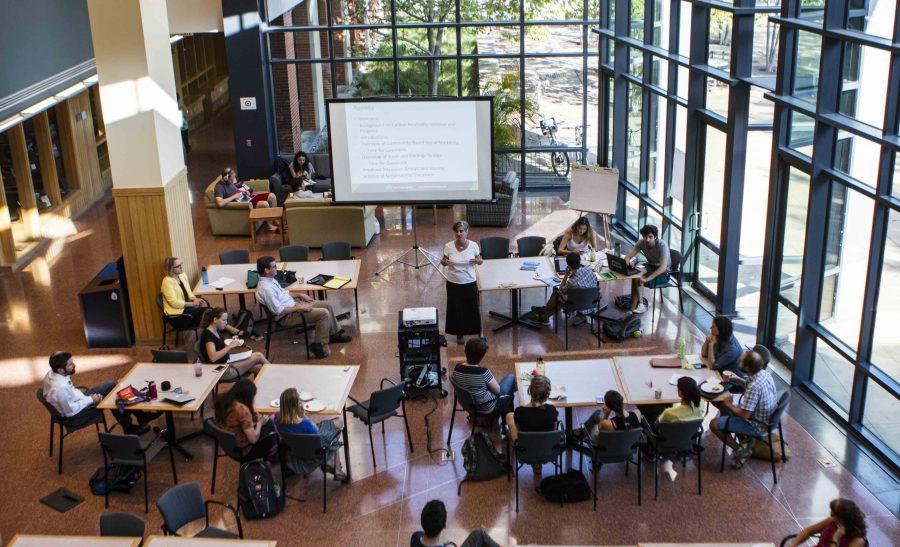College Aims for Carbon Neutrality by 2025
Environmental Studies Professor Cindy Frantz presents on the College’s efforts to reach carbon neutrality in the Science Center. The College has committed to achieving carbon neutrality by 2025.
September 23, 2016
Scattered across the campus, various devices hint at environmental awareness, from the glowing orbs in each dorm that tell students how much energy they use to the composting bins filled to the brim in Stevenson Dining Hall.
The Office of Environmental Sustainability hosted a Carbon Neutrality Forum Tuesday to showcase exactly how the College is planning fulfill its goal of carbon neutrality by 2025.
To reach the 2025 goal, the College brought in the environmental consulting firm Ever- Green Energy to investigate the school’s energy usage and explore cleaner alternatives. Senior Engineer Phil Bourne and Vice President of Public Relations Nina Axelson presented their findings at the forum, but Project Director Michael Ahern was not in attendance.
“As we were invited to be part of this effort, it’s really important to us that we were going to find things that were really going to be flexible, be adaptable, knowing that what this campus needs in 2019 may not be what it needs in 2023,” Axelson said. “It has to be a really versatile solution.”
This presentation marked the completion of a study designed to assess the campus’ energy assets, current and future energy demands, potential for renewable and efficient technology integration and opportunities for consolidating energy resources within the College and community at large. Ever-Green Energy will make recommendations to the College and Board of Trustees about the most efficient and financially viable options.
Among the group’s recommendations is using a landfill gas-recovery system in which the methane gas that is created in landfills is piped to a turbine or engine generator to create electricity. The gas could also be sent to a boiler to produce steam or hot water.
By replacing the fossil fuels consumed by the steam plant, landfill gas would reduce the campus carbon usage by 65 percent compared to the 2015-usage profile. The gas recovery system could also reduce annual campus water consumption by approximately 7 million gallons and reduce annual sewer discharge by 3 million gallons.
Ever-Green Energy estimates that its top-five recommendations would cost around $9 million while their top-15 recommendations would cost around $16 million. Bourne stressed that the goal would be to finance this as creatively as possible through grants, co-partnering and fundraising.
“The goal would be to not hurt any other programs at Oberlin,” Bourne said. “We don’t want to say, ‘implement all of these recommendations at the expense of firing staff or losing funding for clubs.’”
Since the city of Oberlin also wants to become carbon neutral by 2050, Ever-Green Energy worked with city officials including Public Works Director Jeff Baumann to gauge if there is room for crossover in sustainability and energy reduction efforts.
Environmental Studies Professor Cindy Frantz suggested numerous behavioral changes in addition to expensive structural changes that could make a difference at Oberlin, such as taking shorter showers, turning off lights in empty rooms, using cold water for washing clothes or eating a vegetarian diet, which has one of the largest environmental impacts.
Bridget Flynn, Office of Environmental Studies sustainability coordinator, said that in some ways, the label of becoming carbon neutral means much less than actually trying to reduce emissions on campus. Although it would be possible for a College to buy enough Renewable Energy Credits to claim carbon neutrality while not reducing its emissions, it is trying to go about it the hard way.
“It’s possible to go out and buy those and say, ‘OK, we’re carbon neutral,’” Flynn said. “We’re trying to actually reduce our carbon.”
In addition to highlighting the areas that the College needs to work on, the forum also lauded the work that the College has accomplished since establishing the 2025 goal in 2006. According to Flynn, the school has reduced its emissions by more than 50 percent over the last 10 years and Oberlin’s electricity is almost 100 percent renewable.
The event was attended by students, professors and interns from the Office of Environmental Sustainability.
“I was very impressed by how Oberlin is kind of a pilot and a role model for other colleges and communities and that a lot of people are looking to us to see how we’re doing sustainability,” said first-year Olivia Vasquez, who attended the forum.
Senior Environmental Studies major Helena Bader agreed.
“I was very impressed by the reductions Oberlin has accomplished — I didn’t quite realize that — and I think that a lot of times things take place on this campus, and the student body doesn’t really know about them,” Bader said.
The College will begin tracking its yearly emissions and making annual progress reports available to the public through a reporting site called Second Nature.

























